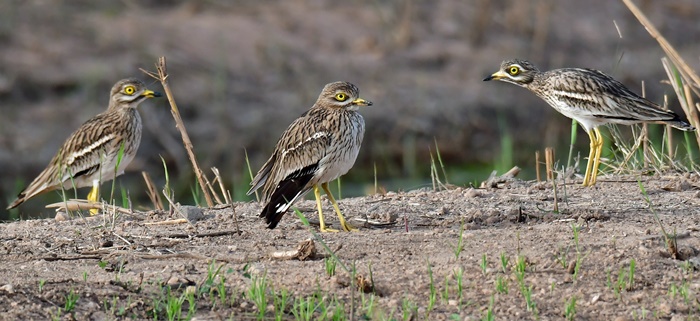The good news from the Clot towards the end of 2016 was that the horrendously overgrown area known by some as the Scrape was finally cleared of the dense reedbed. This shallow wetland area complements the deeper main pool giving species which prefer less water depth a chance to thrive, but it does need constant maintenance, and this clearance is probably two years overdue.
It also gave a chance for observers to see some of the less well-known birds of the area, and my photo shows a group of three Stone Curlews at the Scrape, a species which is regular in the Clot but difficult to see under normal circumstances. This slightly peculiar bird was once known as the Thick-kneed Bustard – early British ornithologists decided it was part of the Bustard family (wrong) and that it had Thick Knees (well, almost); then they realised it wasn’t a Bustard, and because its call sounded a bit like a Curlew, and it lived in stony areas, renamed it the Stone Curlew (wrong again). Actually it belongs to the Plover family, and is known in Spanish as the Alcaraván común.
It is mainly a nocturnal bird, which is why their eyes are large and almost owl-like, and if seen during the day they will usually be motionless, relying on their plumage to camouflage themselves from prying eyes. They are usually found in the quieter parts of the Clot with little vegetation, although I have also seen them at the main pool, and occasionally you may be lucky enough to see one in flight – a crow-sized buff bird with striking black and white wing markings is likely to be one of these.
However, if you are feeling adventurous and fancy a stroll through the Clot at night, the hairs on the back of your head might be subjected to some exercise if you hear this bird calling – it has a somewhat unearthly sound which will put you in mind of spooks and spirits, and you will understand how some of the taller stories about ghostly wailings have come about.
Apart from giving you a dose of the willies, the Stone Curlew is quite an inoffensive bird, even its somewhat stern expression belies its peaceful lifestyle which mainly involves picking around on dry areas for insects and worms. They are rare summer visitors to the UK and confined to a very few locations, but here in Spain they are fairly common throughout the year where there is suitable open and dry habitat. In the Clot, maybe six or seven pairs will nest this coming summer.
I was very lucky to get this photo of the three birds at the Scrape, as it is a very shy bird and will scuttle away if it knows you’re around; perhaps it’s too embarrassed at always being called a Curlew when it isn’t one at all.
See you next month,
Mark



